Decision Making: The Decisive Instant
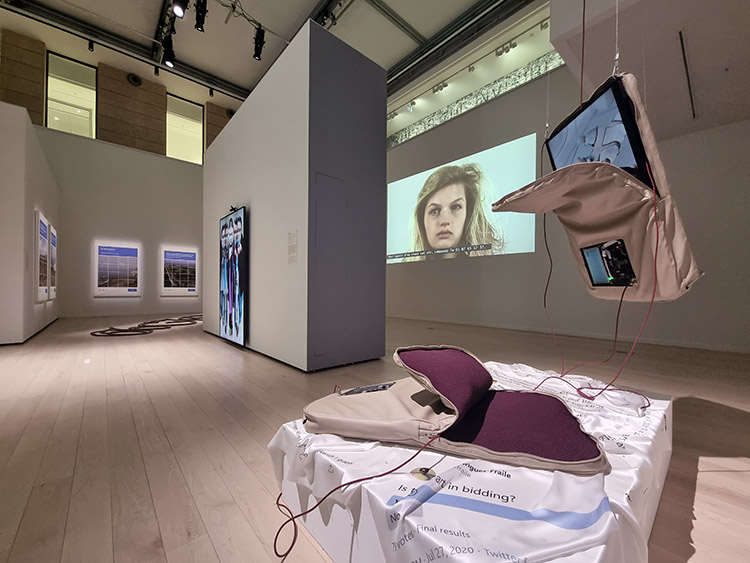
Decision Making, Canadian Cultural Centre, December 10th 2021 - April 15th 2022.
Decisions are the result of complex cognitive processes. Considering them collectively, as they involve our shared futures, makes them nothing less than crucial. But, more and more often, we include machines in such processes through decisional algorithms. Of course, this raises questions that artists know how to put into perspective. Because the age we are currently living in, a simple instant in the history of our planet, is decisive considering the choices available so we can move forward in a world ruled by the responsible and ethical development of Artificial Intelligence. It is now that human rights are at stake, that we can decide what will emerge from the use of our personal data. Experiencing artworks created from decisive processes extracted from the invisible propels us into an immediate future that, for now, still belongs to us.
Data sets
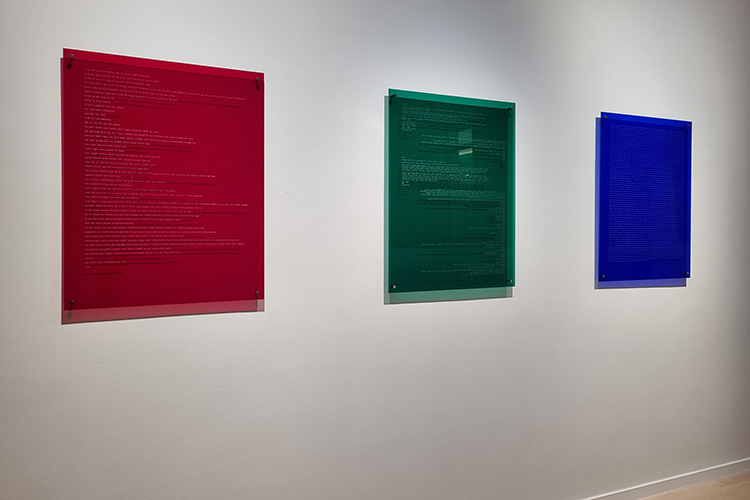
Naomi B Cook, Words Exchanged, 2020, Some words on Special-purpose entities, 2021, Market Findings, 2017.
Naomi B Cook’s triptych of monochromes in pure colours could only refer to the quest for the sublime if each piece did not have a text etched into the plexiglass. The words, rearranged, come from data. And what is interesting is the context of their collection. In the blue work, the words are from a report on the 2010 flash crash of the stock market attributed to high-frequency trading, which gives decision-making algorithms a prominent place in finance. In red, the words are those of users of the dating app Tinder where decisions are made with a gesture of the thumb or index finger. Finally, in green, the words are from a dataset of 600,000 emails exchanged by employees of the American company Enron shortly before its bankruptcy in 2001. A case in which accounting malpractice caused a media stir at the time. The last straw was that the Enron Corpus has since been used to train algorithms capable of making decisions – particularly in terms of tax avoidance.
Crypto Art
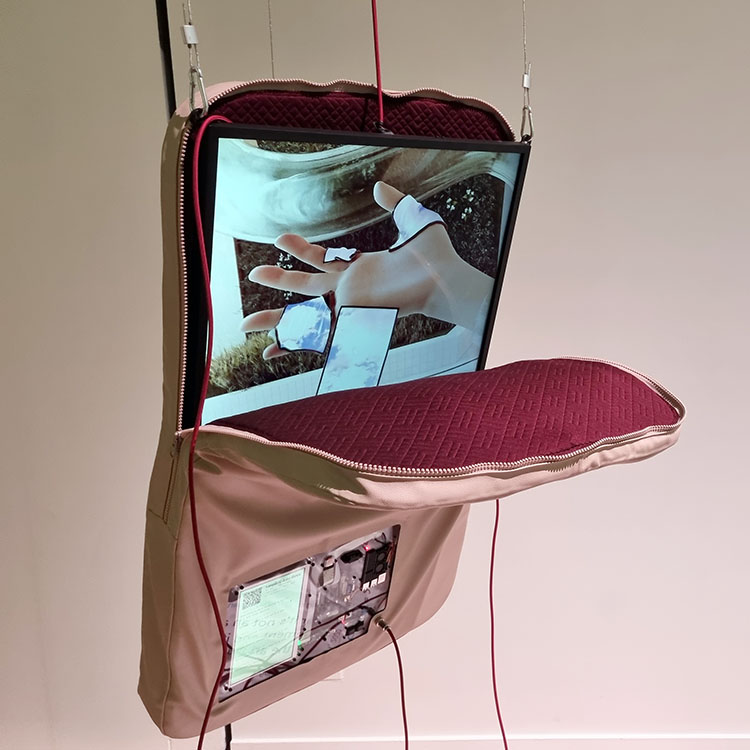
Baron Lanteigne, Tangible Data: Augmented Protective Pouch, 2020.
In 2020 Baron Lanteigne initiated the Tangible Data project, which he deployed on the Internet as well as in exhibitions by infiltrating the cryptoart ecosystem. This new trend in art revolves around non-fungible token (NFT) platforms. For example, SuperRare: collectors acquire virtual works associated with certificates of authenticity secured by databases using blockchain technologies. The hypnotic 3D animation loops he placed there represent the screens of our digital environment to which he confers a relative fluidity. Their content reveals exchanges taking place on Twitter during auctions. The conversations of a community outlining a trend thus become part of the commented works. The artist uses his 3D know-how to prototype video installations such as Tangible Data Three before presenting them in the physical space of exhibitions that can in turn generate comments on Instagram. This is what the sociologist André Gunthert calls “fluid image”.
I’m not a robot
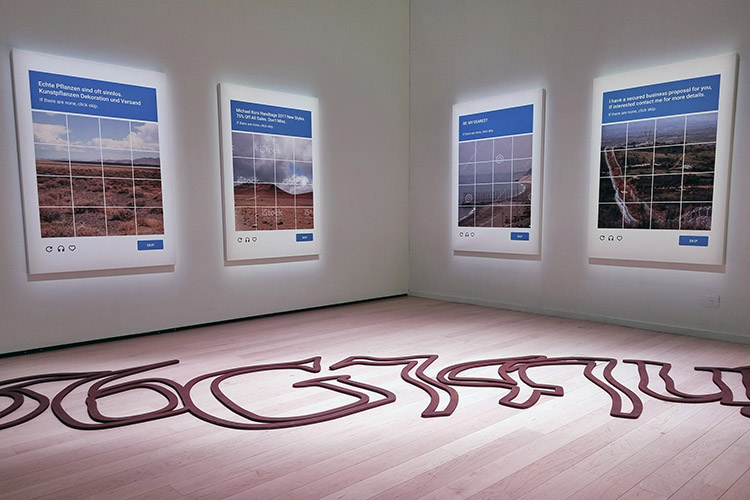
Aram Bartholl, Are you human?, 2013-2017.
Are you human? is a series initiated by Aram Bartholl in 2009. Comprising metal pieces from 2013 and prints from 2017, it revolves around systems for controlling our access to online content. For we are increasingly subjected to tests to access Internet services. Tests that are a variation on the most famous of them all, the Turing test, where a human questions an entity without knowing its nature. But contemporary tests proceed in the opposite direction: it is the computer that interrogates us by subjecting us to tests that we do not always pass. For example, Yahoo’s CAPTCHAs with deformed letters, very popular in 2013. The German artist plays with digital cultures by extracting forms and ideas from the Internet to make them his own. As in 2017 when he was inspired by Google’s reCAPTCHAs, which ask us to recognize elements of images in a grid. By replacing these with photographs of borders, he examines the rite of passage. By associating them with the promises of spams, he questions the motivations that lead to the desire to cross borders.
Of masterpiece
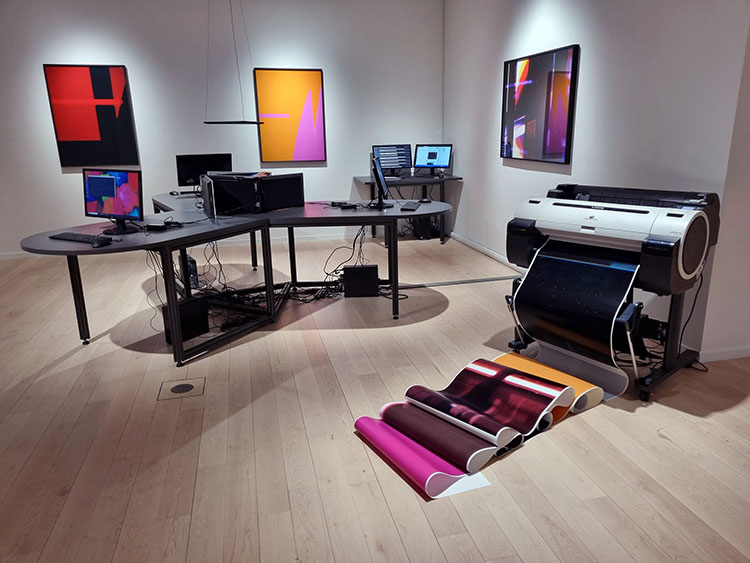
Adam Basanta, All We'd Ever Need Is One Another (Trio), 2019.
All We’d Ever Need Is One Another (Trio) is the three flatbed-scanner version of the two-scanner installation that is now part of the Contemporary Art Museum of Montreal permanent collection. In both cases, the devices are oriented toward each other so they can scan each other. The artist Adam Basanta has automated their functioning, using random settings so that their acquisitions are never repeated. The resulting images are analyzed by a deep-learning algorithm that compares them with large numbers of abstract masterpieces to select only those with sufficient similarities to existing paintings. Only those images that match 83 percent or more of a known work can be printed. Like the ones on the wall, they have been executed “in the manner of”. The idea that, in the field of art, machines know how to copy the great masters more than to create trends is reassuring. But it also tells us that a society that relies too much on artificial intelligence can only repeat itself.
Evaporation of dreams
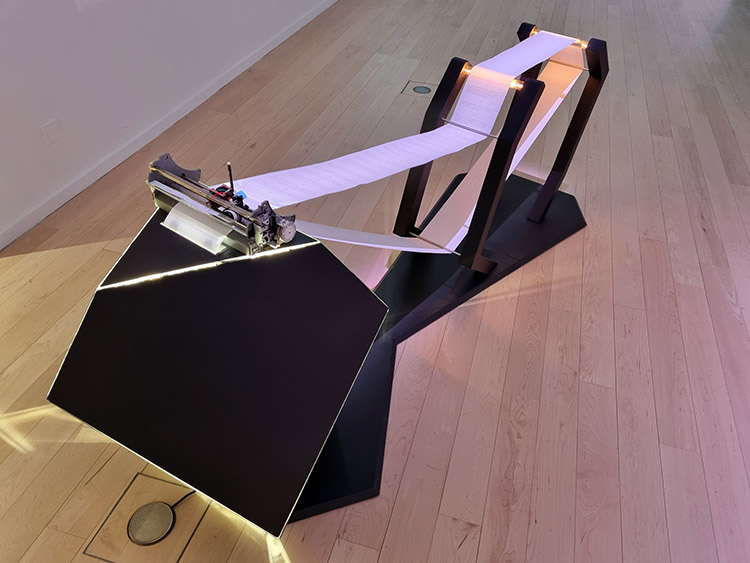
Véronique Béland, Mécanique d'évaporation des rêves, 2018.
One of the most futile undertakings may be the attempt to remember a dream that vanishes with the daylight. Véronique Véronique Béland’s Mécanique d’évaporation des rêves is about just such a utopian endeavour. By equipping a machine with a random text generator, she gives it the ability to dream what a device equipped with a pencil hastens to record on a roll of paper. The process makes a great deal of noise as the machine is activated, as if it was aware of the changeability of its writings. For the ink used is “sympathetic”, that is, it erases itself as the paper tape returns to its inking point. The action of the mechanical device conjuring the magic is also a perfect illustration of the random-access memory with which we have endowed machines, and which is erased every time they are restarted. This is not the case for humans, except for the repressed dreams that many governments around the world would like to never see surface. When the forgetting of our dreams becomes collective, it takes on a whole new dimension.
Principle of uncertainty
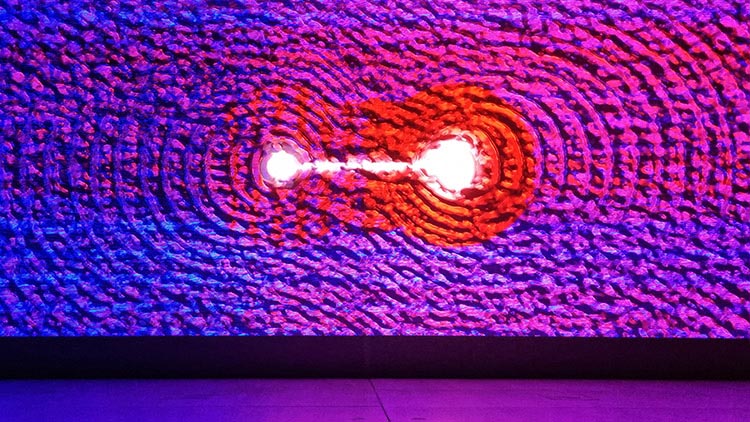
Matthew Biederman & Alain Thibault, Incertitude, 2021.
Whatever the decisions to be made, there are only two possible attitudes. One is to be confident, the other is to be uncertain. It is precisely this Incertitude that Matthew Biederman & Alain Thibault's eponymous performance addresses by merging analog material, and digital control. In this way, radical visual forms are modulated, literally contaminated, by the synthetic sonorities of a resolutely repetitive music in the manner of a Philip Glass on steroids which is, repeatedly, tinged with different types of granulosity. Incertitude thus oscillates between two states going from music to abstract sound, and from formal to particulate visuals - just as we know (without really understanding it) that the qubits in quantum computers "superimpose" the values of 0 and/or 1. It is interesting to note that such machines can only be used in conjunction with more "conventional" computers, both in terms of input and output. This allows a certain form of complexity that the algorithmic granularity of the last part of the performance Incertitude illustrates perfectly - evoking experimental developments in cinema where fields of possibility are never precluded.
Embryogenesis and robotics
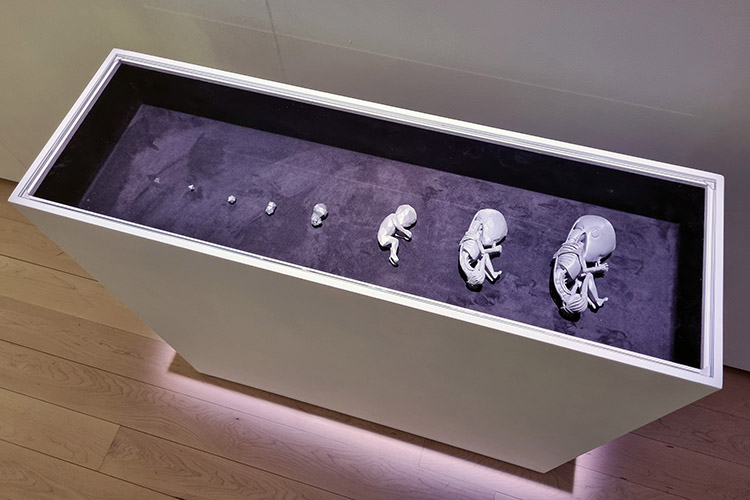
France Cadet, Embryogénèse Poly-gonade, 2018.
The first of the eight stages in the development of the robotic “being” presented by France Cadet is embodied by a tetrahedron, a reference to Greek mathematics and, more precisely, to Plato’s five solids. The object, whose surface looks metallic, is therefore more calculated than designed. And as it becomes more complex, it gradually takes on the appearance of a human embryo, albeit an entirely mechanical one. This different idea of evolution is displayed in a showcase like those in natural history museums. But this is more a question of a possible future that writers of fiction were already anticipating in the previous century. Today, certain currents of thought see science and technology as the answers to all our problems, including those forecasting the disappearance of our own species. Others, artists such as Cadet, draw our attention – not without a certain poetic quality – to the imaginary future, affirming that the decision of how we evolve still belongs to all of us.
Depth of field
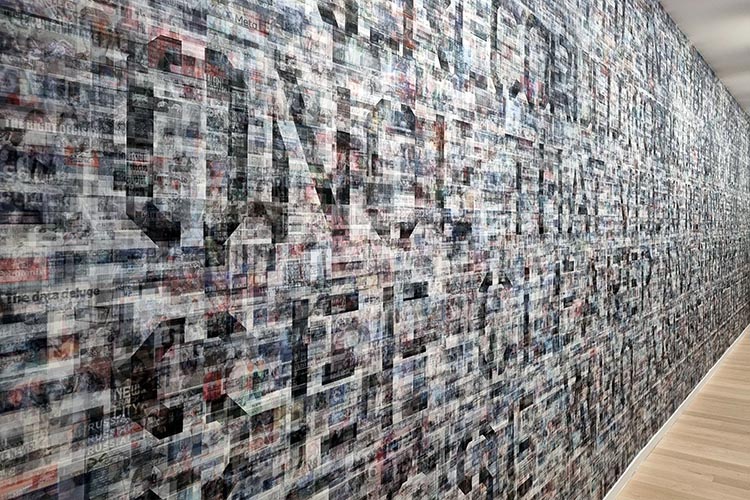
Pascal Dombis, Invisible Generation, 2021.
The international narrative is written on Google’s servers, which Pascal Dombis scans while repeating his image searches. With a few words, he obtains large quantities of visuals. This constitutes the material for installations such as Invisible Generation. He assembles these icons of our times next to each other as well as above each other, obtaining a texture whose depth confers a certain pictorial quality. To decipher them one by one, you need to be equipped with a lenticular sheet with which to draw them out of the invisible. Thus, the gaze must be accompanied by the gesture required to focus, as in photography. Consequently, there are as many stories as there are members of the public who determine, by moving around, the montage of the image. And here, the cinema – the art of time par excellence – comes to mind. The sentence that can be made out on the surface of the installation comes from a text by William Burroughs, whose fondness for the Cut-Up technique is well-known: in literature, it was initially used to bring meaning out of random assemblies of words or sentence fragments.
Head wind
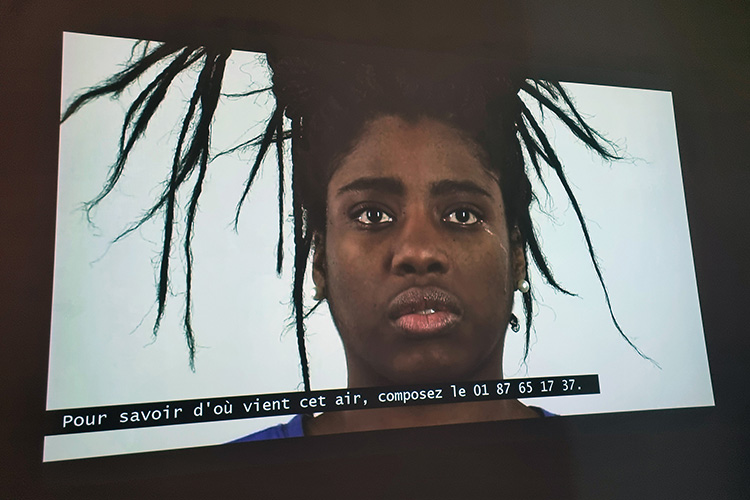
Jean Dubois, Tourmente, 2015-2021.
The context in which Tourmente was created was that of the proliferation of screens with advertising content in the public space. Jean Dubois believes they could be filled in a different way. In his work, we see ordinary people of diverse origins; its particularity lies in the fact that it has a telephone number. Thus, the viewers of the portrait gallery are encouraged to call it. Not to speak, but to blow a virtual wind into the faces of those who are waiting in the image with their microphones. The latter thus receive a current of air whose strength depends on the breath transmitted by the network. With such an interactive device, two temporalities face each other, as they often do on the Internet when it is a question of the responsibility of the users of online services. In this case, an anonymous blast of air addresses a stranger’s image with a certain amount of violence. This raises the question of the cohabitation, through our smartphones, of the private and public spheres. And thus, of our relationship to the stranger who is the other and with whom we communicate with the impression that we know him or her.
Speculative design
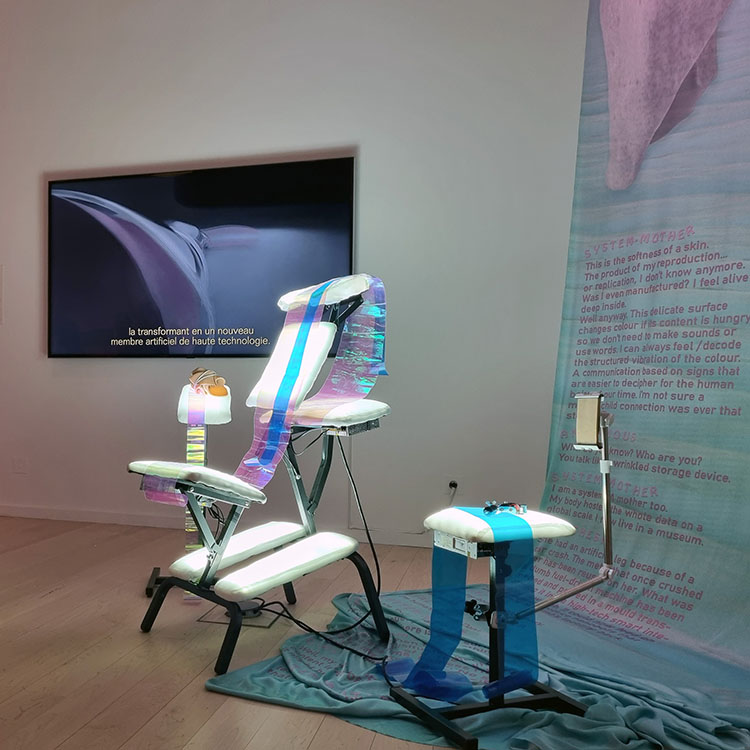
Marie-Eve Levasseur, An Inverted System to Feel (your shared agenda), 2016.
Marie-Eve Levasseur’s An Inverted System to Feel is a work based on an idea, or more precisely, a speculation. What if, in a future that is not as distant as it seems, tattooing could increase the functionality of the skin? The ink would consist of nanoparticles that could store information and change state. The choice of a tattoo parlour for such an operation hint at its possible democratization. As for the uses that could emerge from it, they are multiple, such as having our data “inside us” rather than on or with us, given the technological objects that accompany us everywhere. Also, we could control the colour of our skins at will. Finally, taking the second part of the title of this three-dimensional sequence, “(your shared agenda)”, into consideration, we could share the membrane that separates us from the rest of the world. In such a future, where everyone could decide the colour of their skin, humans would only be more unified. The real question would be that of control, or more precisely of sharing what is still so private to us today.
Multiple temporalities
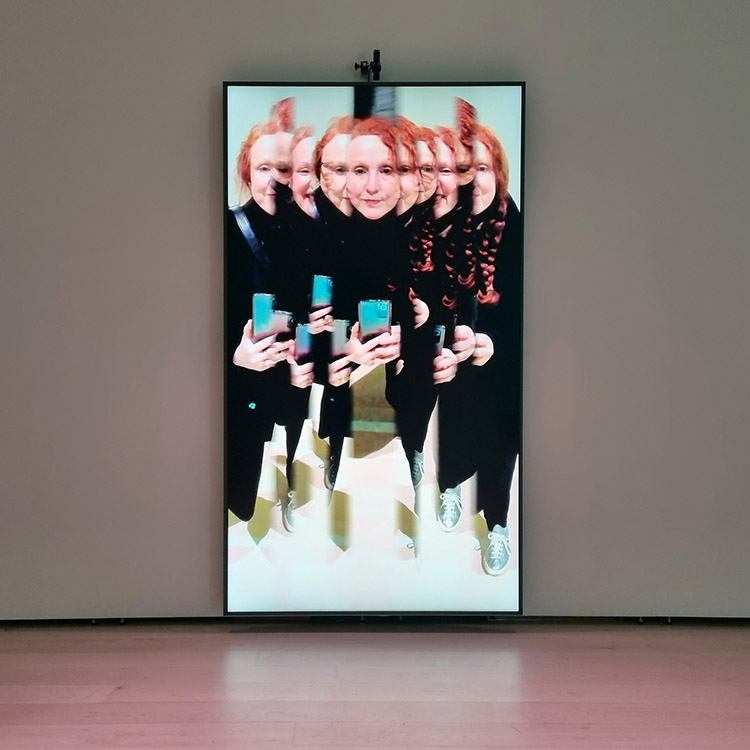
Rafael Lozano-Hemmer, Bilateral Time Slicer, 2016.
Rafael Lozano-Hemmer is an artist who diverts technology, drawing his inspiration from art history to give shape to the present, as in his interactive video installation Bilateral Time Slicer with its immediate past. He uses facial detection, with which surveillance experts are familiar, to encourage the public to “enter” the image. Those who enter then push the footage of others outward. Some of the most obvious references to this device are the symmetrically embedded Aztec mask sculptures with three faces symbolizing the ages of life, as was later the case in paintings by Italian artists. To experience this work is to visualize the fact that the present ineluctably pushes back the past. It also questions our ability, if not our duty, to preserve both the forms and the ideas that have gone before us – although there is much information that we do not wish to archive, let alone use.
Possible future
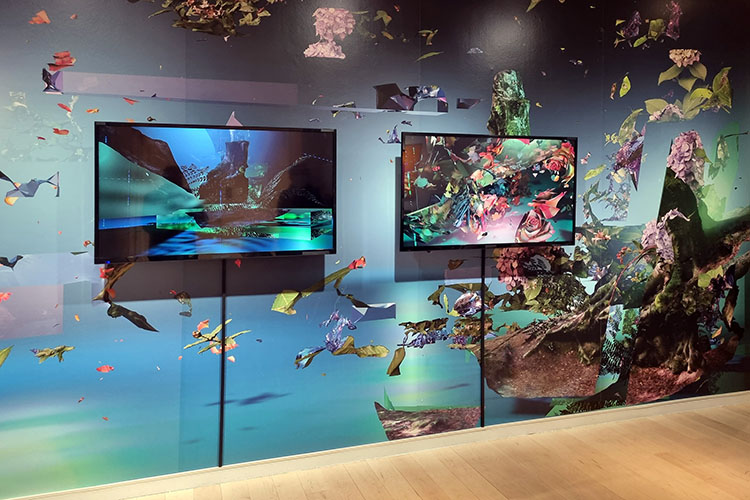
Sabrina Ratté, Floralia, 2021.
In the three-dimensional animations of Sabrina Ratté’s video installation Floralia, the sketch precedes the representation, as is the rule in painting. The somewhat indeterminate appearances of fragments of nature protected by virtual showcases speak to us of their extreme fragility. In a future that we hope is unlikely, these could be museum presentations of plant species of which only the holographs survive. When it comes to exploded views of bouquets of flowers – roses or lilacs – we are literally in the images of a reconstructed nature where photographic documents and three-dimensional models intermingle. The perspectival spaces of the beginnings are also those of the ends of the loops glorifying nature which expresses itself to the rhythm of the seasons. The title of the installation refers to the floral games of ancient Rome celebrating spring, the season of renewal par excellence. In this contemporary era of climate change, it is these seasons with the same beginnings and endings which, because of their increased instability, concern us.
In transparency
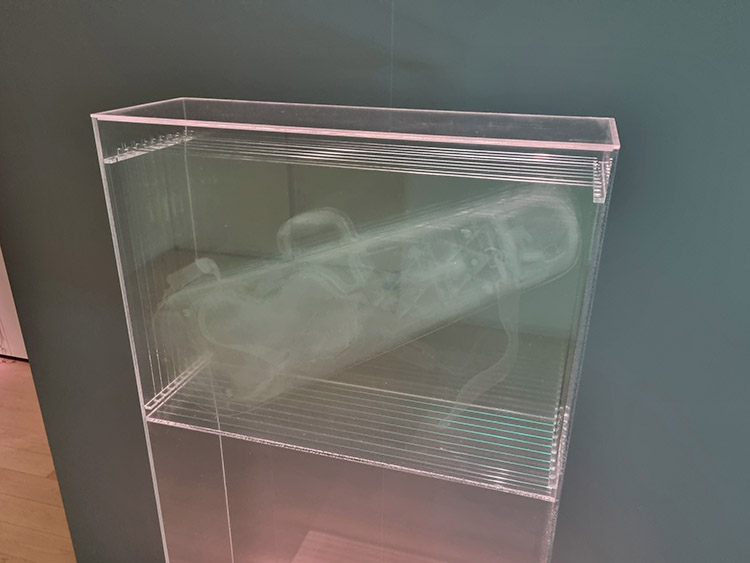
David Spriggs, Transparency Report: Violin, 2014.
The objects David Spriggs depicts are immediately recognizable, although the nature of his works is more difficult to identify. He creates sculptures with assemblages of photographs in which transparency is the real subject. The transparency in question here is like that obtained with electromagnetic radiation, which is free of matter. The violin and especially the suitcase evoke airports security gates whose operators know how to interpret the smallest details of our everyday objects with their indeterminate outlines. Our journeys, at that very moment, are subject to the operators’ decisions. This usually adds to the stress of passage. In the exhibition, the depth of the objects presented to us in the form of successive layers of information encourages us to move around in space to choose the best perspectives. Finally, the diffuse light of David Spriggs’s object-images imbues them with an aura so singular that it makes them profoundly unique.
Enigma
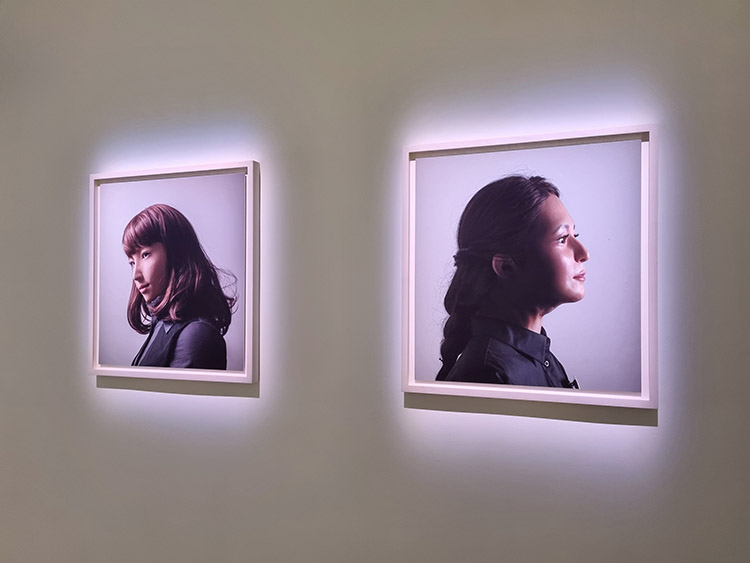
Maija Tammi, One of Them Is a Human, #1–4, 2017.
Maija Tammi is an artist who practices photography, but whose approach to her series of prints One of Them Is a Human is resolutely conceptual. The series consists of four portraits with relatively similar sophisticated frames and lighting. The title invites use to consider this series a game, or rather a test, like that of Alan Turing, to see how human machines are. However, in the case of these portraits of three androids and one human, it is more a question of spotting the non-robotic intruder – unlike in Ridley Scott’s film Blade Runner, where the policeman Deckard must detect the non-human replicants. While the film is set in 2019, Tammi’s photographs were taken in 2017 in the laboratory of Professor Hiroshi Ishiguro, whose robotics research at Osaka University focuses on the sense of presence. It is interesting to note that in the artist’s imagination, the real seems to surpass the fiction that continues to niggle at us.
Counting
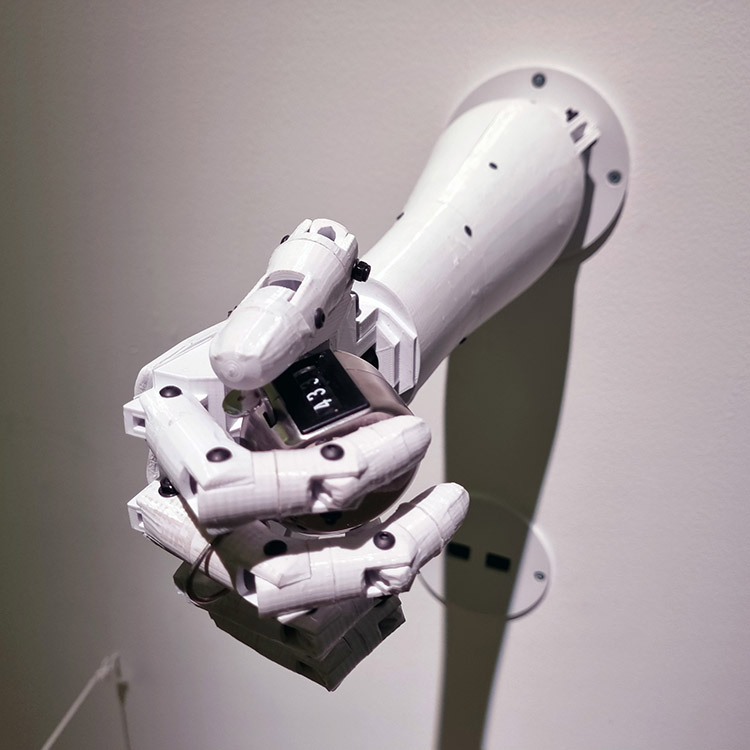
Varvara & Mar, Humans need not to count, 2017.
In the art world, too, people are counted, as they are at the entrance to airplanes, but for different reasons. And it doesn’t matter what the reasons are when we attach such importance to the quantification of things like people. This is what the robotic arm equipped with a hand tally counter by the duo Varvara & Mar seems to be saying. But it also highlights the small laborious jobs that are gradually being taken over by machines because they are so much more efficient and, above all, less expensive. In Paris, for example, the metro ticket punchers have been replaced by automatic turnstiles. We reassure ourselves by saying that the advantage of humans over machines is creativity, as there are still so many operators of repetitive tasks in the world. More and more, the replacement of humans by robots is no longer a question of technology when it is the economy that dictates the rules. The real question is how far to go and what to do if anything. A world where only the machines will be operating for our pure entertainment: dream or nightmare?
Articles
- Paris Photo
- Art, technology and AI
- Immersive Art
- Chroniques Biennial
- 7th Elektra Biennial
- 60th Venice Biennial
- Endless Variations
- Multitude & Singularity
- Another perspective
- The Fusion of Possibilities
- Persistence & Exploration
- Image 3.0
- BioMedia
- 59th Venice Biennale
- Decision Making
- Intelligence in art
- Ars Electronica 2021
- Art & NFT
- Metamorphosis
- An atypical year
- Real Feelings
- Signal - Espace(s) Réciproque(s)
- On Combinations at Work
- Human Learning
- Attitudes and forms by women
- Ars Electronica 2019
- 58th Venice Biennale
- Art, Technology and Trends
- Art in Brussels
- Plurality Of Digital Practices
- The Chroniques Biennial
- Ars Electronica 2018
- Montreal BIAN 2018
- Art In The Age Of The Internet
- Art Brussels 2018
- At ZKM in Karlsruhe
- Lyon Biennale 2017
- Ars Electronica 2017
- Digital Media at Fresnoy
- Art Basel 2017
- 57th Venice Biennial
- Art Brussels 2017
- Ars Electronica, bits and atoms
- The BIAN Montreal: Automata
- Japan, art and innovation
- Electronic Superhighway
- Lyon Biennale 2015
- Ars Electronica 2015
- Art Basel 2015
- The WRO Biennale
- The 56th Venice Biennale
- TodaysArt, The Hague, 2014
- Ars Electronica 2014
- Basel - Digital in Art
- The BIAN Montreal: Physical/ity
- Berlin, festivals and galleries
- Unpainted Munich
- Lyon biennial and then
- Ars Electronica, Total Recall
- The 55th Venice Biennale
- The Elektra Festival of Montreal
- Digital practices of contemporary art
- Berlin, arts technologies and events
- Sound Art @ ZKM, MAC & 104
- Ars Electronica 2012
- Panorama, the fourteenth
- International Digital Arts Biennial
- ZKM, Transmediale, Ikeda and Bartholl
- The Gaîté Lyrique - a year already
- TodaysArt, Almost Cinema and STRP
- The Ars Electronica Festival in Linz
- 54th Venice Biennial
- Elektra, Montreal, 2011
- Pixelache, Helsinki, 2011
- Transmediale, Berlin, 2011
- The STRP festival of Eindhoven
- Ars Electronica repairs the world
- Festivals in the Île-de-France
- Trends in Art Today
- Emerging artistic practices
- The Angel of History
- The Lyon Biennial
- Ars Electronica, Human Nature
- The Venice Biennial
- Nemo & Co
- From Karlsruhe to Berlin
- Media Art in London
- Youniverse, the Seville Biennial
- Ars Electronica, a new cultural economy
- Social Networks and Sonic Practices
- Skin, Media and Interfaces
- Sparks, Pixels and Festivals
- Digital Art in Belgium
- Image Territories, The Fresnoy
- Ars Electronica, goodbye privacy
- Digital Art in Montreal
- C3, ZKM & V2
- Les arts médiatiques en Allemagne
- Grégory Chatonsky
- Le festival Arborescence 2006
- Sept ans d'Art Outsiders
- Le festival Ars Electronica 2006
- Le festival Sonar 2006
- La performance audiovisuelle
- Le festival Transmediale 2006
- Antoine Schmitt
- Eduardo Kac
- Captations et traitements temps réel
- Maurice Benayoun
- Japon, au pays des médias émergents
- Stéphane Maguet
- Les arts numériques à New York